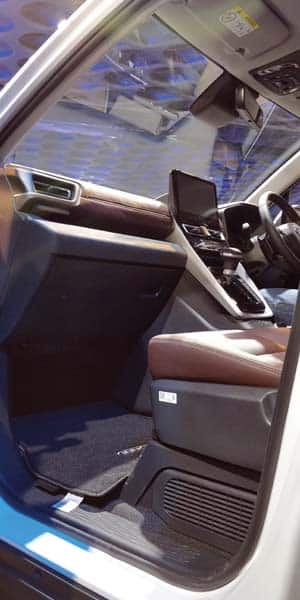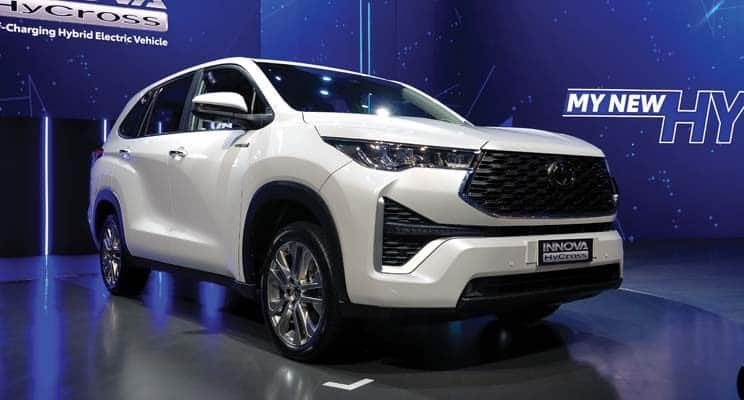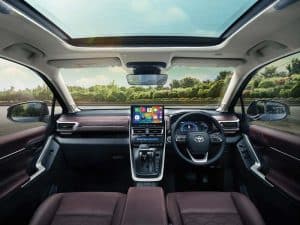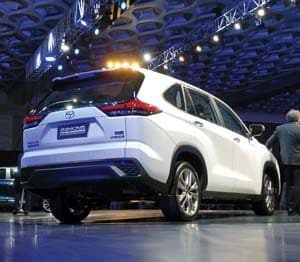Toyota Innova is synonymous with comfortable and roomy road trips in the tours and travel circle. Prateek Pardeshi highlights the USPs of the one-up HyCross and its calling.
The Toyota MPVs are the flag bearers for the ferrying capacity, comfort and the legroom! They bridge the distance to luxury in the tours and travels segment with ease. Operators customise it further to make it their own. From the erstwhile bull bars to the luggage racks to the modern rooftop luggage carriers to the motor homes they’ve tried it all. The Innova is no wonder the flag bearer for Toyota Kirloskar Motors (TKM) in India. So much so, ask a driver and he will give you his own take on the series of Innova iterations (G1-G4) and how the yesteryear Innova differs from the recent Crysta on counts that matter. This is a 17-year journey of the Multi-Purpose Vehicle (MPV) that has left his mark and continues to evolve. It traces its roots back to the Qualis (quailty+service), essentially the ‘Kijang’ of the global market.
Launched at an ex-showroom price of Rs.18.30 lakh for the G 7S variant, the new Innova HyCross goes up to Rs.28.97 lakh for the top variant. An anticipated launch earlier this year, it had fleet operator RC Patil of Om Sai Fleet Management sit up and take notice too. He owns 22 Innovas with two owned and 20 leased by his company. Open to upgrading for better offerings, his first impression hints at his perception of it as an aspiration. For a fleet operator, the Total Cost of Operations (TCO)holds the highest significance over superficial inclusions, unlike a retail private customer. Understandably as he has a higher running at ~ 300-500 kms per day and ~9,000-15,000 kms per month. With more than one million customers like Sharma in India alone and 2.6 million around the globe since 2004, TKM hopes to have got it right with well-thought-out considerations in the HyCross.
The sixth generation MPV (HyCross) comes with a high set of expectations as it’s a new launch after the last BSVI Crysta was rolled out in 2020. According to Hideki Mizuma, Chief Engineer, Innova, Toyota, the manufacturer considers it to be a key launch aimed at aligning with the net zero carbon emissions objectives by 2050. For net zero emission, alternative power trains are a must. The HyCross offers a mix of petrol and hybrid power trains. The hybrids have generated interest among the tour operating circles going by the first reactions. Toyota claimed, a full tank HyCross can cover 1000 kms in comparison to 600 km on the Crysta diesel variant. Commenting on the new launch, Masakazu Yoshimura, Managing Director and Chief Executive Officer, of Toyota Kirloskar Motor mentioned, “We are confident that the new Innova HyCross will carry forward the brand legacy and take customer delight to a new high.” For fleet operators, it is also noteworthy that the diesel Innova will continue to be sold in the coming months. If they are right away convinced, they can opt for the HyCross as a yellow plate option, and flaunt a green badge if the company introduces a pure EV variant in the future. A week prior to the India launch, Innova HyCross made its debut in the Indonesian market under the brand name ‘Innova Zenix’ hinting at commonality and global applicability.
With fuel costs amounting to the most in TCO considerations, the 21 kmpl fuel efficiency ought to live up to its expectation. In a few months, by April 2023, the OEM will also roll out the RDE-compliant HyCross which could play a key factor in sales performance over the next quarter. A crucial factor here is the price hike and high on road costs compared to cheaper alternatives. The company informed of the Diesel Crysta halted on account of over bookings and one will have to see how this plays out with the operators.
 What’s new?
What’s new?
The HyCross doesn’t disappoint! It has the bells and whistles one expects from it. A few hints of Crysta make way into its architecture. Be it the huge grille or the headlamp cluster. A major shift is the monocoque chassis from the previous generation ladder frame architecture. With the new design language Hideki Mizuma, Chief Engineer, Innova, informed of a 200 kg weight reduction attained.
The tour operators could be impressed by the utilities like an electronic parking brake, the inclusion of a panoramic sunroof, and the 10-inch touch infotainment system on the HyCross. LED auto headlamps are also assisted with auto high beam function. No more aftermarket inclusions, perhaps!
To enhance drive ability, the Toyota New Global Architecture (TNGA), 2.0-Litre, four-cylinder BSVI engine produces a max power output of 183.45 hp (186 PS) mated to the Toyota Hybrid System (THS) and e-drive transmission which is claimed to offer swifter gear shifts.
The vehicle also comes with the option of a TNGA 2.0 Litre four-cylinder gasoline engine mated to a direct shift CVT in select grades delivering an output of 171.62 hp (174 PS). That it is governed by the first-in-its-class paddle shifter will impress operators. The luxury offered is premium in class. The operators will have access to the second row equipped with electronic-Ottoman seats that include a calve support. For driver comfort, the front seats are ventilated, and air-conditioned (dual zone, front and rear zone), and offer a retractable sunshade, electronic inner rear view mirror , and an electric-assisted fifth door.
The safety features include the Toyota Safety Sense (TSS) which is a bouquet of Dynamic Radar, Cruise Control, Lane Trace Assist, Rear Cross Traffic Alert, Blind Spot Monitor, and Pre-Collision System. The HyCross also complies with the air bag mandate for the M category vehicles (up to eight seats) with six SRS air bags and offers Rear Disc Brakes Vehicle Stability Control (VSC) Hill Start Assist, Auto Hold, and Antilock Braking System (ABS) with Electronic Brakeforce Distribution (EBDfor additional peace of mind.
 Good choice for fleet operators?
Good choice for fleet operators?
Earlier the petrol Innova had a claimed average of 10.83 kmpl in the automatic variant and 9.89 kmpl on the manual variant. While the Innova Crysta Diesel boasts of a fuel economy of 14.29 kmpl for the 2.8-litre, six-speed automatic transmission variant and 15.10 kmpl for the 2.4-litre, five-speed manual variant. (As per ARAI claims).In comparison, the new HyCross has a claimed average of 21 kmpl. In real-world conditions, it may vary but is a marked improvement over the predecessors. It could help tours and travels operators leapfrog on several counts. This will come at a price.
Also read, https://commercialvehicle.in/honouring-cv-industry-excellence/






























